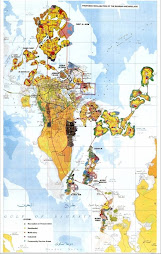Bahrain’s demographics and politics are rather unlike those of most states. In terms of citizenry, it is the only Shiite majority nation still ruled by Sunnis. However, the foreign-born, non-citizen population nearly equals that of actual citizens. Now, a reported 82.5% rise in the foreign-born pop
 ulation, combined with a 15% rise in the number of citizens over the past year, has rekindled fears that Bahrain’s ruling Sunni minority is implementing a rumored plan to suppress the country’s Shiites. Those fears, along with economic discontent, have resulted in riots and protests outside of the capital, Manama.
ulation, combined with a 15% rise in the number of citizens over the past year, has rekindled fears that Bahrain’s ruling Sunni minority is implementing a rumored plan to suppress the country’s Shiites. Those fears, along with economic discontent, have resulted in riots and protests outside of the capital, Manama.In 2006, a former government consultant wrote a 216 page report alleging that the ruling Sunni minority had devised a plan to marginalize Bahrain’s majority Shiite community. The report described a wide conspiracy involving planting false news articles in the local press, naturalizing foreign-born Sunnis, and inciting campaigns against opposition figures via cell-phone text messages. The ensuing controversy, dubbed “Bandargate” by the local media after the report’s author, inspired protests in the capital, led to expulsion on charges of sedition against its author (a British citizen), and resulted in a walkout by Shiite lawmakers after their request for an investigation into the allegations was defeated. Recent rumors that citizenship papers were being distributed to wealthy Saudis has brought the controversy back to the forefront.
As the 2006 Countries at the Crossroads report noted, tensions between Sunni and Shiite communities in Bahrain flared during the mid-1990s alongside general political ferment. Accusations of “political naturalization” also followed a move in 2002 to extend voting rights to Syrians, Yemenis, and Baluchis working in Bahrain’s police, military, and intelligence services. Moreover, absent official government statistics, estimates of unemployment within the majority Shiite community go as high as 50%, with their wages depressed by the large population of low-skill foreign workers.
Nor do Bahraini Shiites’ problems stop at the border. Kuwaiti authorities have recently denied re-entry to Bahraini Shiites returning from pilgrimages to holy sites in Iraq at the Al-Abdelli border crossing because their names appear on a blacklist allegedly provided by Bahraini security services. Charges of collusion between Sunni leaders in Bahrain and Kuwait highlight the regional implications of the imbalance between Sunni and Shia in Bahrain, where Sunnis have stoked fears that the country risks becoming the tip of the much-discussed “Shiite Crescent” dominated by Iranian influence.
Despite the “political naturalization” issue, the foreign-born are by no means immune from the ethno-religious tensions: at the Gulf Cooperation Council in December, Bahrain’s Labor Minister, Majid Al-Alawi, proposed a six-year residency limit for unskilled foreign workers. He cited, in part, the danger hosting such a large population of unassimilated foreign workers presents to local culture. Meanwhile, in an interview earlier this year, he also laid some blame at the feet of Gulf Arabs for being “lazy” and “spoilt,” warning that the “Asian Tsunami” of foreign workers is “worse than an atomic bomb or Israeli attack.”
So how will Bahrain deal with its race (and as the Economist article notes, class) issues without increased violence or repression? An obvious starting point would be greater political openness. After all, one of the great benefits of electoral politics is its ability to channel discontent. But this would, of course, threaten the powers of the monarchy and Sunni elites as much as than sporadic violence. Nobody expects the monarch’s imminent abdication, but even granting parliament somewhat increased powers could help. Nonetheless, the country will need to adopt a more strategic manner of dealing with these issues if it hopes to maintain stability and keep up with its prosperous Gulf neighbors.
Bahrain protest photo by Flickr user Chan'ad







